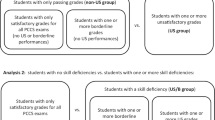Abstract
Purpose
The average age of the matriculating medical student is increasing as more students take time between college and medical school. Increasing numbers of students are employed in the healthcare field during these gap years. Studies have explored the relationship between matriculation age and medical school performance with conflicting findings. The impact of prior healthcare employment (PHE) on future clerkship performance has not been explored. We hypothesize that medical school performance metrics would be higher for students with PHE than their peers.
Methods
A retrospective review of four medical school classes at a single institution was conducted. Each student’s admission application was examined to identify students with at least 6 months paid employment in a clinical healthcare position (i.e., pre-matriculation direct patient interaction, PHE cohort). Multiple medical school performance metrics were obtained for each student.
Results
Of the 434 included students, 49 were PHE (11.29%) and percent of students with PHE trended up over time. MCAT scores, USMLE Step 1, and Step 2 CK scores were not different for PHE and non-PHE medical students. PHE students had significantly higher NBME subject exams, clinical clerkship scores, and cumulative year 3 performance.
Conclusions
Students who matriculate to medical school with prior healthcare employment outperform their peers in the clinical environment, possibly due to acquisition of knowledge or skills from their prior employment. These findings support students seeking paid healthcare experiences prior to medical school and have implications for pre-medicine advising, admissions, and medical school curricula.

Similar content being viewed by others
References
Cook DA, Kuper A, Hatala R, et al. When assessment data are words: validity evidence for qualitative educational assessments. Acad Med. 2016;91(10):1359–69.
American Association of Medical Colleges data tables. Published August 15, 2018; Available from: https://www.aamc.org/download/321442/data/factstablea1.pdf. Accessed December 20, 2018.
Donnon T, Paolucci EO, Violato C. The predictive validity of the MCAT for medical school performance and medical board licensing examinations: a meta-analysis of the published research. Acad Med. 2007;82(1):100–6. https://doi.org/10.1097/01.ACM.0000249878.25186.b7.
Albanese MA, Snow MH, Skochelak SE, Huggett KN, Farrell PM. Assessing personal qualities in medical school admissions. Acad Med. 2003;78(3):313–21. https://doi.org/10.1097/00001888-200303000-00016.
Patterson F, Knight A, Dowell J, et al. How effective are selection methods in medical education? A systematic review. Med Educ. 2016;50(1):36–60. https://doi.org/10.1111/medu.12817.
AAMC. Roadmap to excellence: key concepts for evaluating the impact of medical school holistic admissions. Published; 2013.
Strowd LC, Gao H, O’Brien MC, Reynolds P, Grier D, Peters TR. Performing under pressure: varsity athletes excel in medical school. Med.Sci.Educ. 2019;29:715–20. https://doi.org/10.1007/s40670-019-00730-4.
Martineau M, Brookstone A, Stringham T, et al. Physicians use of EHR systems 2014. American EHR. http://www.americanehr.com/research/reports/Physicians-Use-ofEHR-Systems-2014.aspx. Accessed January 15, 2019.
Gellert GA, Ramirez R, Webster SL. The rise of the medical scribe industry: implications for the advancement of electronic health records. JAMA. 2015;313(13):1315–6.
Brandt BL, Farmer JA Jr, Buckmaster A. Cognitive apprenticeship approach to helping adults learn. New Directions for Adult and Continuing Education. 1993;59:69–78.
Collins A, Brown JS, Newman S. Cognitive apprenticeship: teaching the crafts of reading, writing and mathematics. In: Resnick LB (Ed.). 1989
Denu RA. Whole new breed of doctors: changes in medical school admissions. http://in-training.org/a-whole-new-breed-of-doctors-changes-in-medical-school-admissions-620 Accessed February 18, 2019.
AAMC. Using MCAT data in 2019 medical student selection. Available from: https://www.aamc.org/download/462316/data/mcatguide.pdf Accessed Jaunary 12, 2019.
American Association of Physician Assistants. Available from: https://www.aapa.org/career-central/become-a-pa/. Accessed September 5, 2019.
Higgins R, Moser S, Dereczyk A, Canales R, Stewart G, Schierholtz C, et al. Admission variables as predictors of PANCE scores in physician assistant programs: acomparison study across universities. J Phys Assist Educ. 2010;21(1):10–7.
Honda T, Patel-Junankar D, Baginski R, et al. Admissions variables: predictors of physician assistant student success. J Phys Assist Educ. 2018;29(3):167–72. https://doi.org/10.1097/JPA.0000000000000212.
Funding
Dr. Strowd has received medical education scholarship support from the Brooks Scholarship, an institutional scholarship awarded through Wake Forest University School of Medicine.
Author information
Authors and Affiliations
Corresponding author
Ethics declarations
Conflict of Interest
The authors declare that they have no conflict of interest.
Ethical Approval
This study was approved by the Wake Forest School of Medicine IRB. IRB00043836.
Disclaimers
The authors have no disclaimers.
Additional information
Publisher’s Note
Springer Nature remains neutral with regard to jurisdictional claims in published maps and institutional affiliations.
This work has not been previously presented.
Rights and permissions
About this article
Cite this article
Strowd, L.C., Gao, H., O’Brien, M.C. et al. Prematriculation Healthcare Employment Predicts Success in Clerkship Environment. Med.Sci.Educ. 30, 211–217 (2020). https://doi.org/10.1007/s40670-019-00859-2
Published:
Issue Date:
DOI: https://doi.org/10.1007/s40670-019-00859-2



